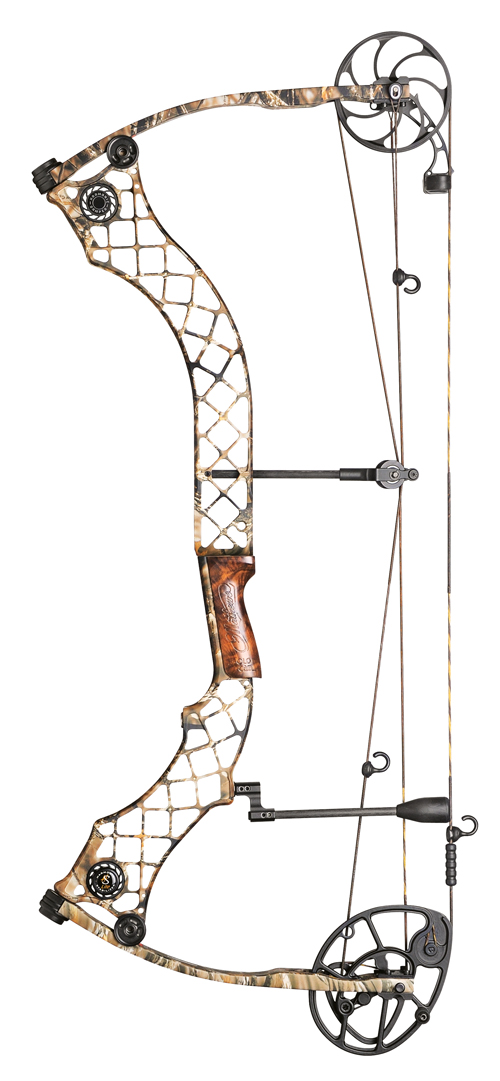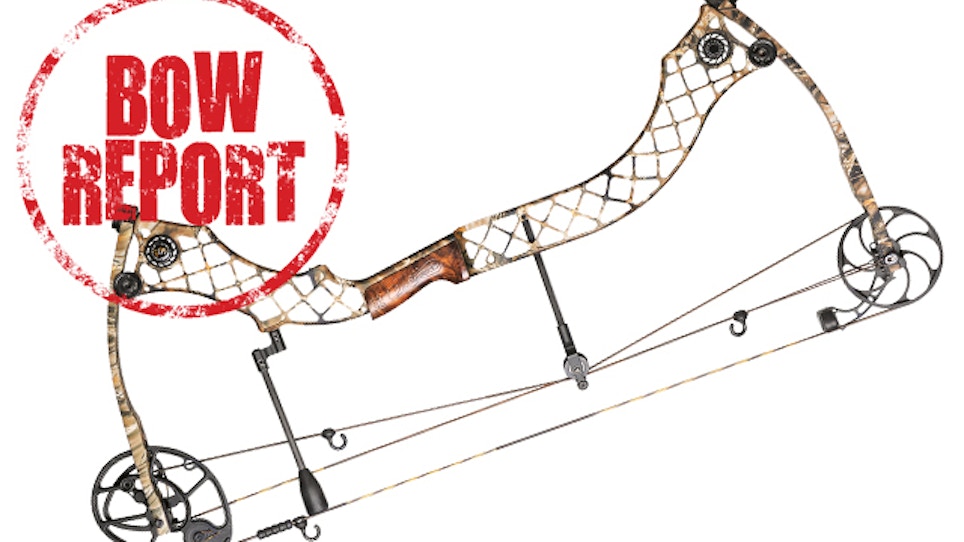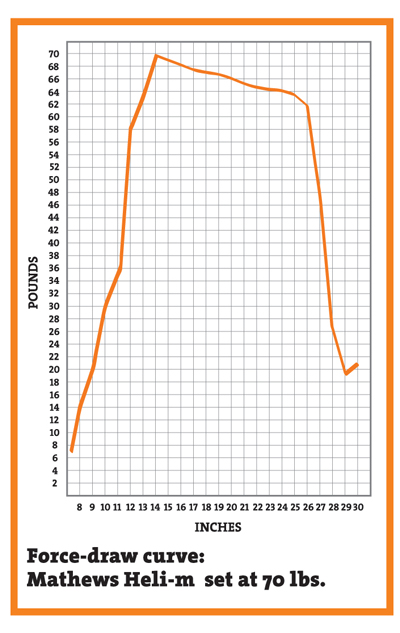The Heli-m is the third generation Mathews bow to offer the distinctive Grid-Lock riser, and with a cam derived from the Z7 this bow is widely regarded as the successor to that extremely popular bow. The name suggests the chief characteristic: At approximately 3.5 pounds, this is one super-light bow.
How Mathews achieved that weight is interesting because it affects other features and characteristics of the bow. To begin with, the new grid lock pattern (Mathews dubs it the GeoGrid) follows the contours of the riser to increase the inherent strength of the design, which allows the individual links of the “grid” to be skinnier, thereby shaving material and weight. The cam is a little larger (more about the cam later) than that on the Z7, but still lighter. Both the string stopper rod and the rod of the cable guard are carbon; this not only achieves some savings in weight, but allows some flexibility in the cable guard rod, which tends to reduce torque. The Heli-m comes without a quiver mount. It’s available as an add-on in a very lightweight composite material. For the bowhunter who chooses not to use a bow-mounted quiver, this achieves further savings in weight. Finally, even the famous Mathews harmonic dampeners are a third of the weight of those on previous models.
 The grip is nicely polished walnut—Mathews refers to it as “gunstock quality,” which it appears to be. It’s a little narrower relative to similar grips on Mathews’ previous models. The string is, of course, Mathews’ own Zebra string, and it comes complete with three Monkey Tails, small vibration and sound reducers similar to String Leeches. There is a fairly large hole in the rim of the cam, and by looking at the bow in profile and determining if the string is aligned through the center of it, shooters can insure at a glance that the cam is properly oriented. This is a small but welcome improvement over systems with obscure, sometimes oddly located little dots or hash marks that can be impossible to see in low light, and which in any case aren’t always easy to interpret. A label on the string warns users that draw weight should be backed off five turns from maximum weight before pressing the bow.
The grip is nicely polished walnut—Mathews refers to it as “gunstock quality,” which it appears to be. It’s a little narrower relative to similar grips on Mathews’ previous models. The string is, of course, Mathews’ own Zebra string, and it comes complete with three Monkey Tails, small vibration and sound reducers similar to String Leeches. There is a fairly large hole in the rim of the cam, and by looking at the bow in profile and determining if the string is aligned through the center of it, shooters can insure at a glance that the cam is properly oriented. This is a small but welcome improvement over systems with obscure, sometimes oddly located little dots or hash marks that can be impossible to see in low light, and which in any case aren’t always easy to interpret. A label on the string warns users that draw weight should be backed off five turns from maximum weight before pressing the bow.
Another distinguishing design feature of this bow is the rubberized draw stop that actually contacts the limb. Any shooter who likes the feel of a single-cam draw cycle, but has lamented the lack of a solid back wall, will appreciate this feature, since it makes for a very definite but quiet stop.
Shooting The Bow
The Heli-m is an insignificant 1 fps slower than the Z7, but with an even smoother draw cycle. Although the draw force curve is steep, peak weight is attained quickly, after which the draw force curve does not so much flatten out as it gradually (then steeply) drops off. The result is a perception that the Heli-m is surprisingly smooth for the speed it achieves. Speeds as measured by chronograph are close to the stated IBO speeds after compensating for heavier hunting arrows and accessories such as D-loops. Even at the nominal IBO top speed of 332 fps, the Heli-m is not a speed demon by current standards, but does achieve the goal of reaching well beyond adequate speed while remaining forgiving, easy to tune, and very pleasant to shoot.
The bow is slightly top-heavy in a way for which a stabilizer will not compensate. That never bothers me in a bow, and some top shooters prefer it. Even shooters who don’t might find that the overall light weight of this bow makes any imbalance a non issue. The light weight of the Heli-m led me to expect some hand shock and vibration; in fact, though I wouldn’t describe this bow as “dead in the hand,” there is no real hand shock, and vibration is minimal even at the maximum draw weight, especially with a stabilizer attached.
Setting up and paper tuning this bow was unusually quick and easy; using nothing but levels and my eyes, my first shot resulted in a slight high-left tear with an unfletched arrow, and in about half a dozens shots the bow was shooting bullet holes.
We looked earlier at the solid stop. I’m among those shooters who have come to prefer a solid back wall, and the stop on the Heli-m makes it as solid as any twin-cam bow. Regarding the grip, while it’s slightly skinnier than previous similar Mathews grips, it’s still a relatively wide grip. I normally prefer a very skinny grip, but have always liked the Mathews grip; any torque is not noticeable, and this grip fits the hand well (my hand, anyway) and seems to slide smoothly into a consistent and comfortable high-wrist hold.
Matt McPherson suggests that the Heli-m is the quietest hunting bow Mathews has yet produced, which is surprising given its weight. Nonetheless, our decibel meter confirmed that this is indeed a very quiet bow.
Overall the Heli-m will be a big hit with those who are already Mathews fans and will no doubt win over some converts.
Mathews Heli-m Specs
Letoff: 80%
Brace Height: 7 inches
Weight: 3.5 pounds
Axle-To-Axle Length: 30 inches
Speed: 332 fps (IBO)
Options: Draw lengths 26 to 30 inches. Draw weights 40, 50, 60, 65, or 70 pounds. Three finishes, Lost Camo, Black, and Tactical.
Our Objective Tests (385-grain arrow)
Peak Hold (pounds): 70 65 60
Weight, Full Draw (pounds): 19 17 17
Arrow Speed (fps): 309 293 286
Kinetic Energy (foot-pounds): 82 73 70
Sound Level (decibels): 78.3 73.8 66







